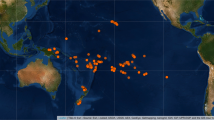Abstract
DURING an avocational search for means of identifying the geographical source of artefact obsidian, what appears to be a functional tool has been found. It was postulated that, because the concentration ratio  in rocks is determined by the origin and age of the rock, it would also be diagnostic of material from a given locality. This communication reports the results of preliminary experiments designed to test the feasibility of the hypothesis.
in rocks is determined by the origin and age of the rock, it would also be diagnostic of material from a given locality. This communication reports the results of preliminary experiments designed to test the feasibility of the hypothesis.
This is a preview of subscription content, access via your institution
Access options
Subscribe to this journal
Receive 51 print issues and online access
$199.00 per year
only $3.90 per issue
Buy this article
- Purchase on Springer Link
- Instant access to full article PDF
Prices may be subject to local taxes which are calculated during checkout
Similar content being viewed by others
References
Heizer, R. F., and Treganza, A. E., Calif. J. Mines Geol., 40, 291 (1944).
Welday, E. E., Baird, A. K., McIntyre, D. B., and Madlem, K. W., Amer. Mineralogist, 49, 889 (1964).
Author information
Authors and Affiliations
Rights and permissions
About this article
Cite this article
PARKS, G., TIEH, T. Identifying the Geographical Source of Artefact Obsidian. Nature 211, 289–290 (1966). https://doi.org/10.1038/211289a0
Issue Date:
DOI: https://doi.org/10.1038/211289a0
Comments
By submitting a comment you agree to abide by our Terms and Community Guidelines. If you find something abusive or that does not comply with our terms or guidelines please flag it as inappropriate.



